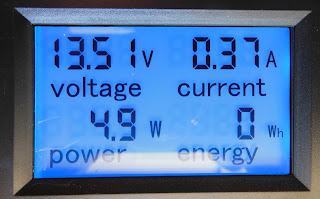All inverters when at idle/standby (not supplying current to a device) draws what’s called a phantom or idle current. This can be an unnecessary drain on your batteries overnight. One way around it is to turn the inverter OFF when not needed, but this can be inconvenient if all lighting or fans you use are 110v.
I have two inverters, both are low-cost, modified sine wave units 87% and 88% efficient purchased from Harbor Freight. One is a 400/800 watt unit and the other is a 1000/2000 watt unit. The 2000 watt is for running a microwave and used only when needed.
Idle current is how much current an inverter draws in a ‘stand by mode’ ready to produce 110volt current for any appliance, fan or lamp that needs inverted power. It’s important to know this amount of current especially if you have a low wattage solar system mounted on an RV or Bug Out Van roof and it’s not possible to align your panels to a perfect angle to capture as much sun energy (watts) as possible. This means you have to be frugal with all the solar power you have available. Turning off the inverter when not needing it will save amps.
For this test, I purchased a load/current meter to verify solar device power consumption:
DROK® Digital Multimeter DC 6.5-100V 20A Voltage Amperage Power Energy Meter DC Volt Amp Tester Gauge Monitor LCD Digital Display with Blue Backlight Measuring Volts Current with Built-in Shunt for $13.99.
Source:
At just $13.99 this is a deal! I’ve seen similar ones at $120.00
It displays battery voltage, amp draw, watt draw and total watt hours consumed also has a built in shunt. Everything is contained in this unit. The display here show the power used with the inverter off.
The meter can be panel mounted. However, I attached 12ga wire and alligator clips to use as a portable test instrument.
Wiring diagram on back side.
Rear view.
The first thing I tested was the idle current of my two inverters and was a little surprised at what I found:
The idle current draw for the smaller 400/800 watt unit is:
0.26 amps (idle current is not specified in the manual or online)
The idle current draw for the larger 1000/2000 watt unit is:
0.37 amps (idle current specified in the manual is 0.8 amps)
The two inverters I own and use:
The 400/800 watt on the left and the 1000/2000 on the right.
Inverter Source:
Inverter test results:
Meter display before attaching either inverter:
Meter display with the 400 watt inverter attached and idling.
Meter display with the 1000 watt inverter attached and idling.
The Voltage reading varies due to small clouds in the area at the time of testing.
What does all this mean?
Let’s use a typical 80 amp hour solar battery. That means the battery can supply 80 amps before it is totally depleted and ruined. Most solar people and battery manufacturers recommend for the longest life from a solar battery is to not discharge more the 20% so in the case of this 12v, 80ah battery you have only “16 amps” to consume before recharging.
If for example:
Using the 1000w inverter that needs 0.37 amps just to idle and you have a charging window from 8:00am until 6:00pm is just 11 hours when the sun can re-charge your system. I have 13 hours of ‘0’ charging time which means 13 x 0.37 = 4.8 amp drain on the battery or approximately 1/3 of the battery’s total usable amps for nothing! Turning off the inverter saves amps for when you need them.
So the summary of this article?
Is simply turn off the inverter when not needed and let the panels replace as much current as possible to the batteries!







Neat test I was surprised at the 1000 watt inverter drawing less. I know your roof mount is to conform to HOA rules, But could you cart mount them during an emergency and move them to a sunnier spot ? You have a sixty amp hour possible.
ReplyDeleteI’ve ordered and have most of the order so far to rewire my panels with the proper gauge wire from 12ga to 4ga. That will be an interesting test to see how much if any the amps increase. At the same time been giving a lot of thought to making my panels portable for better sun alignment and get more power from them and in case of a bad hurricane they will be with me and not lost to flying debris wind damage on the roof.
ReplyDeleteThanks for post this great. I'm a long time reader but ive
ReplyDeletenever commented till now.
Thanks again for the awesome post.
Thanks for post this amazing. I'm a long time reader
ReplyDeletebut ive never commented till now.
Thanks again for the awesome post.